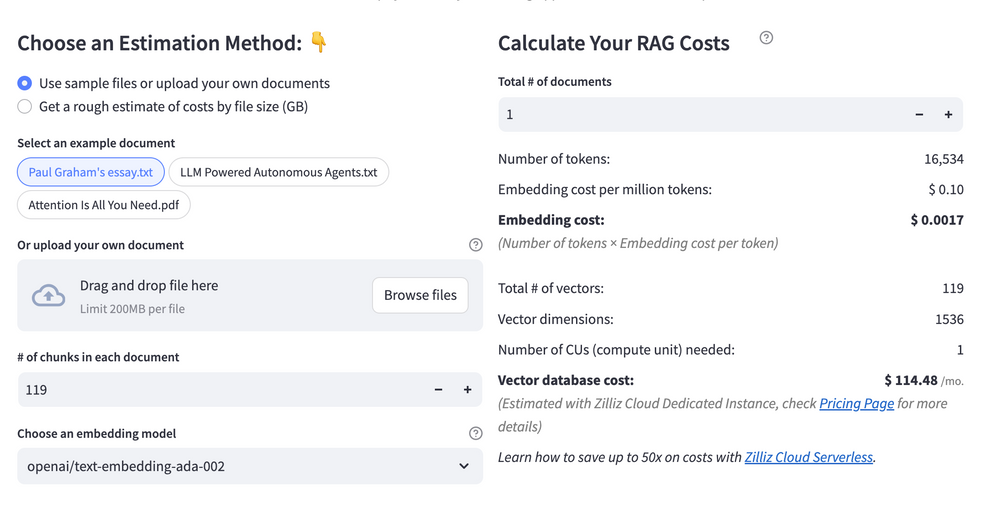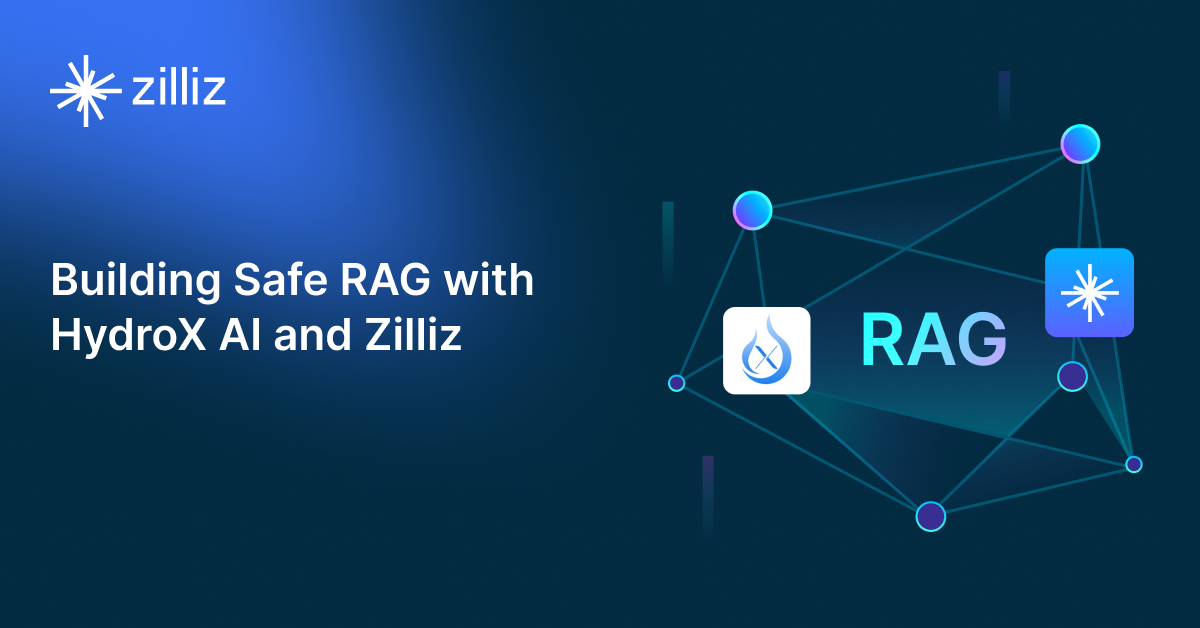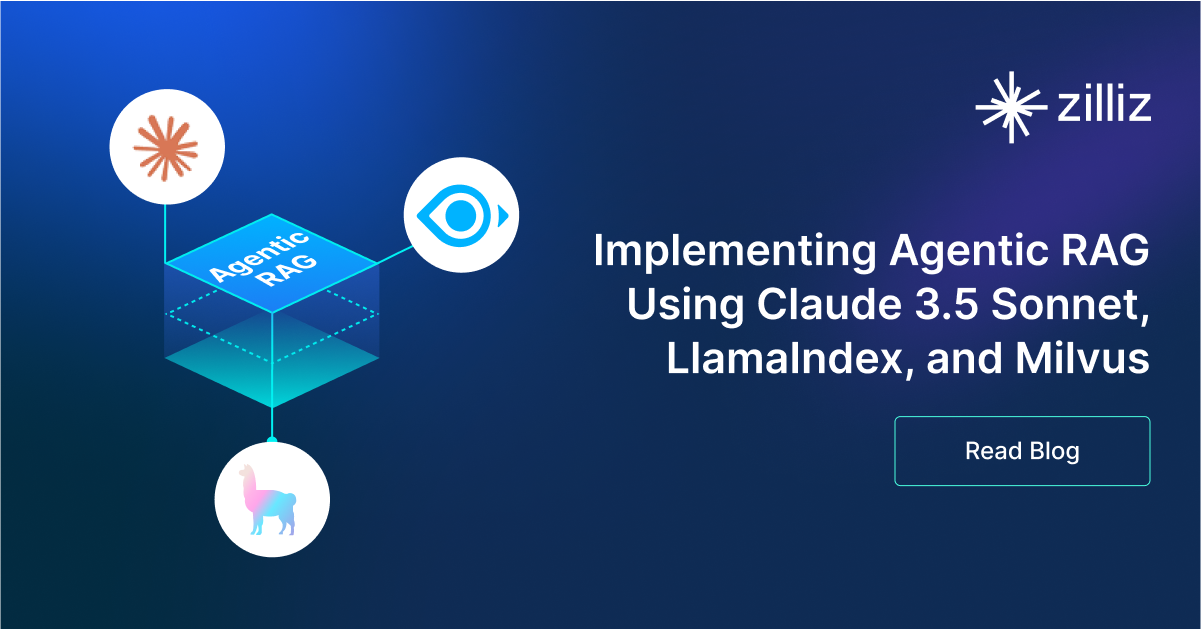Build RAG Chatbot with LangChain, Milvus, Anthropic Claude 3 Haiku, and IBM slate-125m-english-rtrvr
Introduction to RAG
Retrieval-Augmented Generation (RAG) is a game-changer for GenAI applications, especially in conversational AI. It combines the power of pre-trained large language models (LLMs) like OpenAI’s GPT with external knowledge sources stored in vector databases such as Milvus and Zilliz Cloud, allowing for more accurate, contextually relevant, and up-to-date response generation. A RAG pipeline usually consists of four basic components: a vector database, an embedding model, an LLM, and a framework.
Key Components We'll Use for This RAG Chatbot
This tutorial shows you how to build a simple RAG chatbot in Python using the following components:
- LangChain: An open-source framework that helps you orchestrate the interaction between LLMs, vector stores, embedding models, etc, making it easier to integrate a RAG pipeline.
- Milvus: An open-source vector database optimized to store, index, and search large-scale vector embeddings efficiently, perfect for use cases like RAG, semantic search, and recommender systems. If you hate to manage your own infrastructure, we recommend using Zilliz Cloud, which is a fully managed vector database service built on Milvus and offers a free tier supporting up to 1 million vectors.
- Anthropic Claude 3: This advanced AI language model from Anthropic focuses on safety and alignment, capable of generating coherent and context-aware text. It excels in creative writing, conversational AI, and insightful summarization. Ideal for creating engaging content while ensuring adherence to ethical standards and user intent.
- IBM slate-125m-english-rtrvr: This model is designed for fine-tuning English text retrieval tasks, leveraging a slim and efficient architecture. Its strength lies in fast processing and high accuracy, making it ideal for applications that require quick and relevant information retrieval from large text datasets. Use cases include document search engines, chatbots, and content recommendation systems.
By the end of this tutorial, you’ll have a functional chatbot capable of answering questions based on a custom knowledge base.
Note: Since we may use proprietary models in our tutorials, make sure you have the required API key beforehand.
Step 1: Install and Set Up LangChain
%pip install --quiet --upgrade langchain-text-splitters langchain-community langgraph
Step 2: Install and Set Up Anthropic Claude 3 Haiku
pip install -qU "langchain[anthropic]"
import getpass
import os
if not os.environ.get("ANTHROPIC_API_KEY"):
os.environ["ANTHROPIC_API_KEY"] = getpass.getpass("Enter API key for Anthropic: ")
from langchain.chat_models import init_chat_model
llm = init_chat_model("claude-3-haiku-20240307", model_provider="anthropic")
Step 3: Install and Set Up IBM slate-125m-english-rtrvr
pip install -qU langchain-ibm
import getpass
import os
if not os.environ.get("WATSONX_APIKEY"):
os.environ["WATSONX_APIKEY"] = getpass.getpass("Enter API key for IBM watsonx: ")
from langchain_ibm import WatsonxEmbeddings
embeddings = WatsonxEmbeddings(
model_id="ibm/slate-125m-english-rtrvr",
url="https://us-south.ml.cloud.ibm.com",
project_id="<WATSONX PROJECT_ID>",
)
Step 4: Install and Set Up Milvus
pip install -qU langchain-milvus
from langchain_milvus import Milvus
vector_store = Milvus(embedding_function=embeddings)
Step 5: Build a RAG Chatbot
Now that you’ve set up all components, let’s start to build a simple chatbot. We’ll use the Milvus introduction doc as a private knowledge base. You can replace it with your own dataset to customize your RAG chatbot.
import bs4
from langchain import hub
from langchain_community.document_loaders import WebBaseLoader
from langchain_core.documents import Document
from langchain_text_splitters import RecursiveCharacterTextSplitter
from langgraph.graph import START, StateGraph
from typing_extensions import List, TypedDict
# Load and chunk contents of the blog
loader = WebBaseLoader(
web_paths=("https://milvus.io/docs/overview.md",),
bs_kwargs=dict(
parse_only=bs4.SoupStrainer(
class_=("doc-style doc-post-content")
)
),
)
docs = loader.load()
text_splitter = RecursiveCharacterTextSplitter(chunk_size=1000, chunk_overlap=200)
all_splits = text_splitter.split_documents(docs)
# Index chunks
_ = vector_store.add_documents(documents=all_splits)
# Define prompt for question-answering
prompt = hub.pull("rlm/rag-prompt")
# Define state for application
class State(TypedDict):
question: str
context: List[Document]
answer: str
# Define application steps
def retrieve(state: State):
retrieved_docs = vector_store.similarity_search(state["question"])
return {"context": retrieved_docs}
def generate(state: State):
docs_content = "\n\n".join(doc.page_content for doc in state["context"])
messages = prompt.invoke({"question": state["question"], "context": docs_content})
response = llm.invoke(messages)
return {"answer": response.content}
# Compile application and test
graph_builder = StateGraph(State).add_sequence([retrieve, generate])
graph_builder.add_edge(START, "retrieve")
graph = graph_builder.compile()
Test the Chatbot
Yeah! You've built your own chatbot. Let's ask the chatbot a question.
response = graph.invoke({"question": "What data types does Milvus support?"})
print(response["answer"])
Example Output
Milvus supports various data types including sparse vectors, binary vectors, JSON, and arrays. Additionally, it handles common numerical and character types, making it versatile for different data modeling needs. This allows users to manage unstructured or multi-modal data efficiently.
Optimization Tips
As you build your RAG system, optimization is key to ensuring peak performance and efficiency. While setting up the components is an essential first step, fine-tuning each one will help you create a solution that works even better and scales seamlessly. In this section, we’ll share some practical tips for optimizing all these components, giving you the edge to build smarter, faster, and more responsive RAG applications.
LangChain optimization tips
To optimize LangChain, focus on minimizing redundant operations in your workflow by structuring your chains and agents efficiently. Use caching to avoid repeated computations, speeding up your system, and experiment with modular design to ensure that components like models or databases can be easily swapped out. This will provide both flexibility and efficiency, allowing you to quickly scale your system without unnecessary delays or complications.
Milvus optimization tips
Milvus serves as a highly efficient vector database, critical for retrieval tasks in a RAG system. To optimize its performance, ensure that indexes are properly built to balance speed and accuracy; consider utilizing HNSW (Hierarchical Navigable Small World) for efficient nearest neighbor search where response time is crucial. Partitioning data based on usage patterns can enhance query performance and reduce load times, enabling better scalability. Regularly monitor and adjust cache settings based on query frequency to avoid latency during data retrieval. Employ batch processing for vector insertions, which can minimize database lock contention and enhance overall throughput. Additionally, fine-tune the model parameters by experimenting with the dimensionality of the vectors; higher dimensions can improve retrieval accuracy but may increase search time, necessitating a balance tailored to your specific use case and hardware infrastructure.
Anthropic Claude 3 Haiku optimization tips
Claude 3 Haiku is designed for efficiency, making it a great choice for low-latency RAG applications. Optimize token usage by structuring prompts concisely, removing redundant text, and leveraging system messages effectively to guide responses. Use function calling when applicable to offload structured processing tasks and improve response reliability. Batch process queries where possible to reduce API overhead and enhance throughput. If latency is critical, consider caching frequent queries and pre-generating responses for common questions. Fine-tune response control with temperature and top-p sampling; lower temperature values (e.g., 0.2-0.3) help maintain consistency in factual retrieval tasks. Use streaming mode for real-time applications to get faster partial responses while processing large prompts. Regularly evaluate and adjust model parameters based on performance benchmarks to balance speed and accuracy in your RAG pipeline.
IBM slate-125m-english-rtrvr optimization tips
To optimize the IBM slate-125m-english-rtrvr for Retrieval-Augmented Generation (RAG), ensure that your document retrieval system is fine-tuned with domain-specific data to improve relevance. Utilize embeddings effectively by implementing cosine similarity for efficient nearest neighbor searches, and consider applying caching mechanisms to store frequently accessed documents. Additionally, experiment with various query augmentation techniques, like rephrasing or adding related keywords, to enhance retrieval performance. Monitor and analyze retrieval metrics (such as precision and recall) to iteratively refine your setup, and if possible, implement an ensemble approach by integrating multiple retrieval models to boost diversity in retrieved content. Finally, regularly update your corpus to reflect current knowledge and trends.
By implementing these tips across your components, you'll be able to enhance the performance and functionality of your RAG system, ensuring it’s optimized for both speed and accuracy. Keep testing, iterating, and refining your setup to stay ahead in the ever-evolving world of AI development.
RAG Cost Calculator: A Free Tool to Calculate Your Cost in Seconds
Estimating the cost of a Retrieval-Augmented Generation (RAG) pipeline involves analyzing expenses across vector storage, compute resources, and API usage. Key cost drivers include vector database queries, embedding generation, and LLM inference.
RAG Cost Calculator is a free tool that quickly estimates the cost of building a RAG pipeline, including chunking, embedding, vector storage/search, and LLM generation. It also helps you identify cost-saving opportunities and achieve up to 10x cost reduction on vector databases with the serverless option.
 Calculate your RAG cost
Calculate your RAG cost
What Have You Learned?
By diving into this tutorial, you’ve unlocked the power of integrating cutting-edge tools to build a robust RAG system from the ground up! You learned how LangChain acts as the glue, seamlessly orchestrating workflows between components like a conductor leading an orchestra. Milvus stepped in as your high-performance vector database, storing and retrieving embeddings at lightning speed, while Anthropic’s Claude 3 Haiku brought its nimble, cost-effective intelligence to the table—perfect for generating precise, context-aware responses. The IBM slate-125m-english-rtrvr embedding model transformed your raw text into rich numerical representations, bridging the gap between human language and machine understanding. Together, these tools formed a dynamic pipeline that fetches relevant data, processes it intelligently, and delivers answers that feel almost magical in their accuracy. You also picked up pro tips for optimizing performance, like tweaking chunking strategies and adjusting similarity thresholds, plus how to use the free RAG cost calculator to balance quality and budget—a game-changer for real-world applications!
Now, with this toolkit in your hands, you’re ready to create RAG systems that feel less like code and more like superpowers. Imagine the chatbots, search engines, or research assistants you could build, each tailored to solve unique problems with speed and precision. This isn’t just about following steps—it’s about innovating, experimenting, and pushing boundaries. Tweak those parameters, test different models, and watch your ideas come alive. The future of intelligent applications is yours to shape, and you’ve got everything you need to start today. So fire up your IDE, embrace the thrill of iteration, and let your creativity run wild. The world’s waiting for what you’ll build next—go blow us all away! 🚀
Further Resources
🌟 In addition to this RAG tutorial, unleash your full potential with these incredible resources to level up your RAG skills.
- How to Build a Multimodal RAG | Documentation
- How to Enhance the Performance of Your RAG Pipeline
- Graph RAG with Milvus | Documentation
- How to Evaluate RAG Applications - Zilliz Learn
- Generative AI Resource Hub | Zilliz
We'd Love to Hear What You Think!
We’d love to hear your thoughts! 🌟 Leave your questions or comments below or join our vibrant Milvus Discord community to share your experiences, ask questions, or connect with thousands of AI enthusiasts. Your journey matters to us!
If you like this tutorial, show your support by giving our Milvus GitHub repo a star ⭐—it means the world to us and inspires us to keep creating! 💖
- Introduction to RAG
- Key Components We'll Use for This RAG Chatbot
- Step 1: Install and Set Up LangChain
- Step 2: Install and Set Up Anthropic Claude 3 Haiku
- Step 3: Install and Set Up IBM slate-125m-english-rtrvr
- Step 4: Install and Set Up Milvus
- Step 5: Build a RAG Chatbot
- Optimization Tips
- RAG Cost Calculator: A Free Tool to Calculate Your Cost in Seconds
- What Have You Learned?
- Further Resources
- We'd Love to Hear What You Think!
Content
Vector Database at Scale
Zilliz Cloud is a fully-managed vector database built for scale, perfect for your RAG apps.
Try Zilliz Cloud for Free


